Worksheet Solutions: Fractions | Worksheets with Solutions for Class 5 PDF Download
Q1: Divide each collection into two equal parts by dotted lines:
(i) 
(ii) 
(iii) 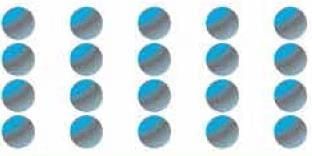
Ans: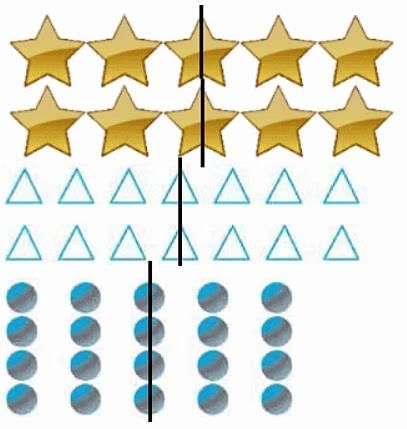
Q2: In each of the following write the fraction representing the shaded portion:
(i) 
Ans: = 1/3
(ii) 
Ans: = 1/4
(iii) 
Ans: = 1/3
Q3: Write the fraction whose.
(i) Numerator is 7 and denominator is 15.
Ans: 7/15
(ii) Numerator is 22 and denominator is 35.
Ans: 22/35
Q4: Divide each collection into a suitable number of equal parts and fill in the blanks:
(i) 
1/2 of 8 = ______.
Ans: 4
(ii) 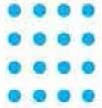
1/8 of 16 = ______.
Ans: 2
(iii) 
5/6 of 18 = ______.
Ans: 15
Q5: Draw a collection of objects. Divide the collection into suitable number of equal parts and find
(i) 1/3 of 9
Ans:
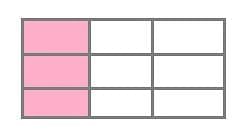
= 3
(ii) 3/7 of 14
Ans: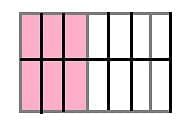
= 6
(iii) 4/9 of 18
Ans: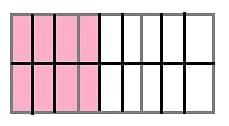
= 8
Q6: Write the next three equivalent fractions of each of the following
(i) 1/4
Ans:2/8, 4/16, 8/32
(ii) 2/3
Ans: 4/6, 8/12, 16/24
(iii) 5/9
Ans: 10/18, 20/36, 40/72
(iv) 4/7
Ans: 8/14, 16/28, 32/56
Q7: Fill in the missing numerators to make the statement true:
(i) 
Ans: 15
(ii) 
Ans: 5
(iii) 
Ans: 5
Q8: Find an equivalent fraction of 3/4 with:
(i) Numerator 15
Ans: Equivalent fraction of 3/4 with numerator 15: (3/4) × (5/5) = 15/20.
(ii) Denominator 48
Ans: Equivalent fraction of 3/4 with denominator 48: (3/4) x (12/12) = 36/48.
(iii) denominator 24
Ans: Equivalent fraction of 3/4 with denominator 24: (3/4) × (6/6) = 18/24.
Q9: Fill in the missing denominators to make the statement true:
(i) 
Ans: 21
(ii) 
Ans: 9
(iii) 
Ans: 40
Q10: Check whether the given fractions are equivalent:
(i) 3/15, 1/5
Ans: 3/15 in the simplest form is 1/5, thus equivalent.
(ii) 2/11, 6/21
Ans: 6/21 in the simplest form is 2/7, thus not equivalent.
(iii) 4/9, 8/18
Ans: 8/18 in the simplest form is 4/9, thus equivalent.
Q11: State whether the fraction is in its lowest terms or not:
(i) 12/20
Ans: NO
The simplest form of 12/20 is 3/5.
(ii) 4/6
Ans: NO
The simplest form of 4/6 is 2/3.
(iii) 80/81
Ans: YES
The simplest form of 80/81 is 80/81 itself.
Q12: Reduce to the lowest terms:
(i) 21/28
Ans: The simplest form of 21/28 is 3/4.
(ii) 45/60
Ans: The simplest form of 45/60 is 3/4.
(iii) 36/54
Ans: The simplest form of 36/54 is 2/3.
Q13: Encircle the fraction which is in its lowest terms:
(i) 
(ii) 
Ans:
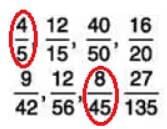
Q14: Fill in the blanks by putting > or < in each of the following to make the statement true:
(i) 
Ans: >
(ii) 
(iii) 
Q15: Which is smaller in each of the following pairs of fractions?
(i) 3/16, 21/32
Ans: We need to make the denominator equal first,
3/16 x 2/2 = 6/32
6/32 < 21/32
(ii) 18/25, 2/5
Ans: We need to make the denominator equal first,
2/5 x 5/5 = 10/25
18/25 > 10/25
(iii) 8/21, 7/20
Ans: We need to make the denominator equal first,
LCM = 420
8/21 x 20/20 = 160/420
7/20 x 21/21 = 147/420
Q16: Find the sum:
(i) 1/8 + 2/8 + 3/8
Ans: 6/8
(ii) 1/13 + 3/13 + 8/13
Ans: 12/13
(iii) 9/35 + 2/35 + 11/35
Ans: 22/35
Q17: Write the fractions whose numerator is 6 and denominator is 19.
Ans: 6/19
Q18: 
Ans: (1+2+4)/7 = 1.
FAQs on Worksheet Solutions: Fractions - Worksheets with Solutions for Class 5
| 1. What are fractions and how are they represented? |  |
| 2. How do you add and subtract fractions with the same denominator? |  |
| 3. What is the process for adding fractions with different denominators? |  |
| 4. How do you simplify fractions? |  |
| 5. What are mixed numbers and how can they be converted to improper fractions? |  |
















